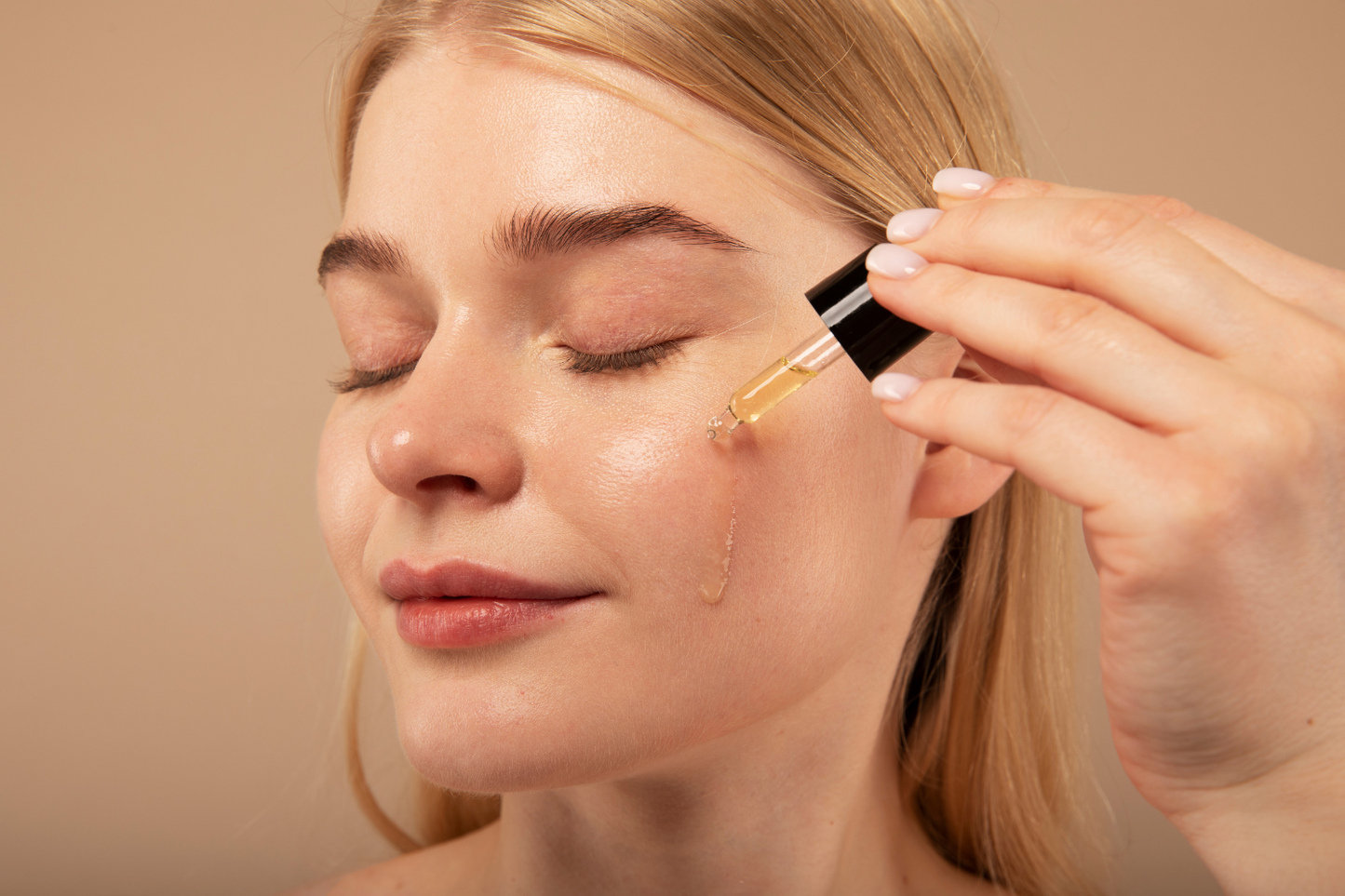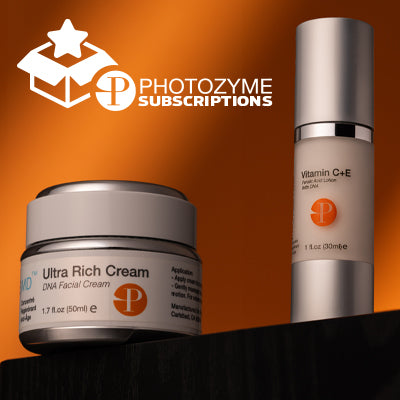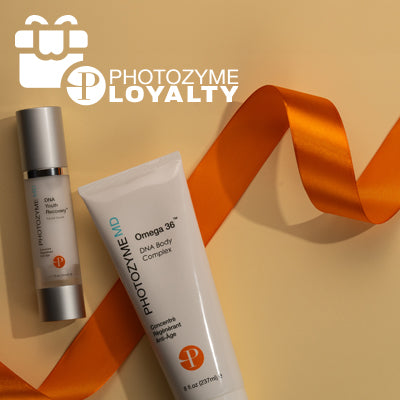
Get radiant, youthful skin, now. Learn how to layer hyaluronic acid and retinol for maximum results with Photozyme’s clinically-proven anti-aging formulas.
Key Takeaways:
- Dual-Ingredient Power: Combining hyaluronic acid and retinol enhances hydration and boosts anti-aging efficacy, ensuring smoother, more radiant skin with less irritation.
- Barrier-Friendly Layering: Strategic layering of these ingredients maximizes retinol benefits while maintaining a resilient skin barrier, allowing for consistent and effective use.
- Professional-Grade Performance: Understanding the nuances of product application and incorporating Photozyme's advanced formulations can catalyze visible skin transformation, empowering professionals and skincare enthusiasts.
Pairing hyaluronic acid and retinol can significantly improve your skincare routine, but knowing when and how to use each is key. When layered strategically, these two ingredients synergize to amplify hydration, reduce irritation, and accelerate visible renewal. However, misuse can compromise your skin barrier or blunt retinol’s impact. Understanding order, timing, and compatibility ensures maximum results from these powerhouse actives. Here’s where most routines go wrong – and how to get it right.
At Photozyme, our patented DNA repair enzymes are clinically proven to correct photodamage and support true skin rejuvenation. Trusted by dermatologists and built on biotechnology, our products bring you robust health solutions. For those who expect more than surface-level results, we deliver formulations that restore, strengthen, and visibly transform with every use.
In this article, we will explore the science behind combining hyaluronic acid and retinol, outline the correct order of application, and provide expert tips to help you build a skin-renewing routine that delivers hydration, resilience, and long-term anti-aging results.
Benefits Of Combining Hyaluronic Acid And Retinol
When you harness the synergistic power of hyaluronic acid and retinol, you get a multifaceted approach to skin rejuvenation. These two powerhouse ingredients offer distinct, scientifically proven advantages – yet together, their benefits are amplified.
Enhanced Hydration And Tolerance
Retinol is revered for its ability to accelerate cellular turnover and diminish visible signs of aging, but it can also introduce dryness or irritation, especially during initial use. This is where hyaluronic acid steps in. As a humectant, hyaluronic acid draws moisture deep into the skin, reinforcing your moisture barrier and cushioning against the potential dehydrating effects of retinol. The result is a smoother, more comfortable retinol experience, with less sensitivity and flakiness. Those looking for the best retinol cream for wrinkles often find that pairing it with a hydrating base enhances performance and comfort.
Boosted Anti-Aging Efficacy
Retinol stimulates collagen production and refines skin texture, working at a cellular level to reduce lines, wrinkles, and hyperpigmentation. Paired with hyaluronic acid, which plumps and hydrates from within, your skin appears firmer and benefits from enhanced elasticity and visible fullness. These effects combine to leave your complexion balanced, youthful, and resilient. Many users rely on a retinol anti-aging cream formulated explicitly with hydrating actives to achieve these comprehensive results.
Support For Skin Barrier Integrity
A robust skin barrier is essential for long-term skin health, particularly when integrating potent actives like retinol. Hyaluronic acid supports barrier recovery by replenishing lost moisture and reducing trans-epidermal water loss, allowing your skin to tolerate retinol better and maximize its transformative potential.
Optimized Results Over Time
Layering these ingredients allows you to incorporate retinol more consistently, which is key to seeing meaningful texture, tone, and overall luminosity improvements. Rather than sacrificing efficacy for comfort, combining hyaluronic acid and retinol in your regimen can allow you to experience the full spectrum of benefits – visible rejuvenation, improved hydration, and sustained skin health.
Potential Side Effects And How To Prevent Them
Combining hyaluronic acid and retinol can yield remarkable improvements in skin texture, hydration, and visible signs of aging. However, introducing these active ingredients—especially retinol – may provoke temporary side effects if not appropriately layered.
Common Side Effects
- Dryness & Peeling: Retinol accelerates cell turnover, which can initially result in flakiness, dryness, or mild peeling.
- Irritation & Redness: Sensitivity, redness, or tingling may occur as your skin acclimates, particularly if you have a delicate complexion or incorporate retinol too quickly.
- Transient Breakouts: Some may experience purging, a short period where blemishes surface as pores clear.
Prevention Strategies
- Start Slow: Introduce retinol gradually—begin with two to three nights per week, slowly increasing frequency as your skin’s tolerance builds.
- Apply Hyaluronic Acid First: Use hyaluronic acid on cleansed, slightly damp skin. This primes your skin with a surge of hydration, creating a buffer that helps minimize the irritation often associated with retinol.
- Use A Gentle Cleanser & Avoid Exfoliants: Pair your regimen with a mild, fragrance-free cleanser. Avoid layering alpha hydroxy acids, scrubs, or other potential irritants until your skin is fully acclimated.
- Seal With Moisturizer: Finish with a nourishing, barrier-supporting moisturizer to lock in hydration and protect against dryness. Layering with a DNA repair serum can strengthen the skin’s defense system and help accelerate recovery from irritation or environmental stress.
- Prioritize Sun Protection: Retinol increases sensitivity to UV exposure. Incorporate a broad-spectrum sunscreen in your morning routine – even on cloudy days – to shield your skin and prevent further photodamage.
Step-by-Step Guide To Layering For Maximum Results
Achieving optimal benefits from hyaluronic acid and retinol involves strategic, science-driven layering. Here’s how to integrate both actives into your nighttime regimen for transformation you can see – and feel.
1. Start With A Gentle Cleanse
Begin by thoroughly cleansing your skin to remove impurities, excess oil, and any traces of sunscreen or makeup. Choose a mild, pH-balanced cleanser that doesn’t strip the barrier, setting the stage for better absorption of actives.
2. Pat – Don’t Rub Your Face Dry
After rinsing, gently pat your skin dry, leaving it slightly damp. Hyaluronic acid performs best with some moisture present, helping it draw hydration deep into the epidermis.
3. Apply Hyaluronic Acid First
Dispense a small amount of your hyaluronic acid serum and smooth it evenly over the face and neck. This step delivers an immediate infusion of moisture, plumping skin and optimizing cellular receptiveness for the next layer.
4. Give It A Minute
Allow the hyaluronic acid to settle for 60 to 90 seconds. This ensures it hydrates efficiently and prevents dilution or interference with the potency of your retinol.
5. Layer On The Retinol
Next, apply your retinol serum or cream. If you’re new to retinoids, begin with a low concentration, gradually increasing frequency as tolerance builds. Focus on areas with visible signs of aging, using a pea-sized amount to avoid over-application. Unsure about how often to use retinol? Start with two to three nights a week, adjusting based on your skin’s response. And if you're wondering whether to use retinol or moisturizer first, always apply retinol before moisturizing to preserve its efficacy and avoid dilution.
6. Seal With A Nourishing Moisturizer
Finish with a rich, emollient moisturizer. This final layer locks in hydration, soothes potential irritation, and reinforces your skin’s protective barrier for visible firmness and luminosity.
7. Don’t Forget Sun Protection (Morning Only)
If you incorporate retinol into your morning routine, always follow with broad-spectrum SPF. Retinoids can increase photosensitivity, and daily sun defense is non-negotiable for maintaining and accelerating your results.
For best results, know what not to use with retinol. Avoid pairing it with strong acids like AHAs or BHAs and vitamin C in the same routine, as these combinations may increase irritation or reduce stability.
How To Choose The Right Products For Your Skin Type
Selecting the ideal hyaluronic acid and retinol products for your regimen is essential to maximize results and ensure optimal skin health. While both ingredients are cornerstones of advanced anti-aging skincare, their efficacy hinges on thoughtful formulation and compatibility with your unique skin type.
For Dry Or Sensitive Skin
Choose hyaluronic acid serums that utilize multiple molecular weights for layered hydration and enhanced absorption. Dual or triple-weight hyaluronic acid helps attract and retain moisture on the surface and deeper within the skin. Pair this with a retinol formula buffered by soothing agents like niacinamide, ceramides, or panthenol to minimize the risk of irritation and support the skin barrier during nightly renewal. If you’re searching for the best retinol for sensitive skin, opt for formulations labeled as gentle or encapsulated to deliver efficacy without compromising comfort.
For Oily Or Acne-Prone Skin
Opt for lightweight, oil-free hyaluronic acid serums that provide hydration without congestion. When choosing a retinol, look for encapsulated or slow-release technologies; these gradually deliver retinoids to your skin, enhancing effectiveness while reducing the likelihood of breakouts or peeling. Formulas that include salicylic acid or gentle clarifying peptides can also offer synergy, helping to keep pores clear and skin texture refined. Whether retinol does help with acne is crucial, and it turns out it’s well-documented for regulating oil production, preventing clogged pores, and accelerating skin renewal, making it a proven choice for managing breakouts.
For Mature Or Photodamaged Skin
Potent, professionally formulated retinol fused with supporting antioxidants, such as vitamin E, ferulic acid, and peptide complexes, delivers multi-pronged rejuvenation. Pairing these with a high-viscosity, nourishing hyaluronic acid serum will further replenish moisture reserves and reinforce elasticity, allowing retinol to work more effectively on lines, discoloration, and uneven tone.
Always perform a patch test before introducing new active ingredients and adjust the frequency based on your skin’s tolerance level. The right combination of hyaluronic acid and retinol, selected with your skin’s specific needs in mind, paves the way for visible and sustainable transformation.
Addressing Myths About Hyaluronic Acid And Retinol
In advanced skincare, myths about hyaluronic acid and retinol abound, often clouding the science and leading to confusion. Let's set the record straight by debunking some of the most persistent misconceptions surrounding these powerhouse ingredients.
Myth 1: Hyaluronic Acid And Retinol Can’t Be Used Together
One of the most common myths is that hyaluronic acid and retinol should never be layered. In reality, they complement each other perfectly. Retinol is renowned for accelerating cellular turnover and targeting fine lines, while hyaluronic acid draws moisture into the skin. Hyaluronic acid can help buffer potential retinol-induced dryness, maximizing comfort without sacrificing results.
Myth 2: Using Retinol Always Leads To Severe Irritation
While retinol is a clinically proven, transformative ingredient, not everyone will experience redness or peeling, especially with proper formulation and mindful layering. Gentle introduction, using soothing and hydrating ingredients like hyaluronic acid, can significantly reduce the risk of irritation. This is especially important when comparing tretinoin vs. retinol – tretinoin often causes more intense side effects due to its prescription-strength potency.
Myth 3: Hyaluronic Acid “Exfoliates” The Skin
Despite its name, hyaluronic acid does not exfoliate. Unlike alpha or beta hydroxy acids, hyaluronic acid is a humectant – it binds water to the skin, deeply hydrating and plumping the epidermis without disrupting the barrier.
Myth 4: Retinol Should Be Avoided If Your Skin Feels Dry
Some believe that dry, dehydrated skin is a no-go for retinol. In truth, dryness often results from an impaired barrier or lack of hydration. Layering with hyaluronic acid ensures the skin maintains optimal moisture levels, allowing even those with dehydrated skin to incorporate retinol effectively. This is worth considering in the context of adapalene vs. retinol, as adapalene may be more tolerable for oily or acne-prone skin types.
Myth 5: The Benefits Are Immediate
Both hyaluronic acid and retinol deliver impressive results, but patience is key. Hyaluronic acid offers an instant plumping effect, but the long-term improvements in texture, elasticity, and visible aging from retinol typically emerge with consistent use over several weeks. Understanding retinol vs. retinoid can also help set realistic expectations – retinoid is a broader category that includes more potent prescription derivatives like tretinoin and adapalene.
Separating fact from fiction empowers you to make science-driven decisions and confidently integrate these clinically proven ingredients for maximum impact.
Final Thoughts
Layering hyaluronic acid and retinol is about leveraging proven science to amplify results and protect your skin’s health for the long term. Combining hyaluronic acid's deep hydration with retinol's cell-renewing power creates the best solution for sensitive skin. This may enhance retinol’s efficacy, minimizing potential irritation, and ensuring your skin barrier remains resilient and plump.
At Photozyme, we see the value of precision and innovation at every step. Our DNA repair enzyme technology, featured in professional-grade formulas such as the DNA Youth Recovery Facial Serum and GFS Plus Night Serum, is designed to address photodamage at the cellular level while providing advanced protection against environmental stressors. Integrate these solutions into your layered skincare routine to correct signs of aging and prevent future damage, delivering visible, long-lasting results.
And for those ready to commit to consistency, our retinol subscription ensures you never miss a dose of your most essential anti-aging ingredient. Enjoy effortless refills, exclusive savings, and peace of mind knowing your skincare regimen stays uninterrupted.
Read also:
- Is Hyaluronic Acid Good For Acne? Here's What You Need To Know
- Retinol Or Moisturizer First? The Quick Guide To Layering Your Skincare Products
-
What Not To Use With Retinol: Ingredients To Avoid For Maximum Effectiveness
Frequently Asked Questions About Hyaluronic Acid And Retinol
What order should I apply hyaluronic acid and retinol?
Start with retinol on clean, dry skin to maximize its efficacy, as it penetrates best without barriers. Follow with hyaluronic acid to infuse the skin with moisture and reinforce the skin barrier. This sequence ensures optimal absorption and reduces the risk of dehydration, which is often associated with retinol use.
How long should I wait between applying hyaluronic acid and retinol?
After applying retinol, allow it to absorb thoroughly – generally 10 to 15 minutes. This gives the active molecules time to interact with your skin and reduces the risk of neutralizing the retinol’s potency when you layer on hyaluronic acid or other products.
Why should I layer hyaluronic acid with retinol?
Layering hyaluronic acid with retinol leverages the best of both ingredients. Retinol transforms skin texture and targets visible signs of aging, while hyaluronic acid replenishes and retains moisture. This strategic pairing maximizes results and promotes balanced, revitalized skin without the discomfort of dryness.
Should I apply moisturizer after retinol and hyaluronic acid?
Yes. After using retinol and hyaluronic acid, seal in the benefits with a professional-grade moisturizer, such as Photozyme’s Ultra Rich DNA Facial Cream. A final moisturizing step locks in hydration, calms any sensitivity, and supports overall skin barrier health for optimal anti-aging outcomes.
Can layering hyaluronic acid and retinol cause irritation?
When applied correctly – starting with retinol and followed by hyaluronic acid – the risk of irritation is significantly reduced. Hyaluronic acid’s soothing, hydrating properties mitigate the sensitivity sometimes caused by retinol. Always introduce new actives gradually and monitor your skin’s response, particularly with professional-grade formulations.
Is it safe to use hyaluronic acid every day with retinol?
Yes. Hyaluronic acid is gentle enough for daily use alongside retinol and is encouraged as part of an advanced routine. Its ability to draw moisture into the skin makes it an ideal companion for nightly retinol applications, ensuring sustained hydration and supporting visible age-defying results.





